Nakajima Ki-84-1 Hayate
(meaning "Gale" in Japanese and known as "Frank" to the Allies)
(Hasegawa 1/48)
by Akio Hasegawa, M.D.
The kit is Hasegawa's 1/48 Imperial Japanese Army Type 4 Fighter. I purchased two packages of this kit on discount second-hand sale at specialized shop in Akihabara district of Japan, one kit was being partly assembled with tapes, in essense virgin, costing only 300 Yen, circa 4 USD! Best for backup parts in case of some failure in the making). My primary objective is to make Hayate of Lt. Col. Shigeo Uehara, 22 Squadron (Regiment?) of the Japanese Imperial Army, KIA at age 28 on air defence duty over Odawara City on February 16 1945, however I will make two kits parallelly in different color schema ("silver" and "green", for detail see description 2012.7.27-28).
My page on Lt. Uehara; "Visiting a grave in Odawara City of our fallen hero: Lt. Col. Shigeo Uehara", KIA on February 16 1945 at age 28 (in Japanese)
Ki-84 was designed by Yasushi Koyama (main designer and R and D manager, graduate 1925 of the Tohoku Imperial University), and Ha-45 "Homare" engine was designed by Ryoichi Nakagawa (main designer and R and D manager, graduate 1936 of the section of mechanichal engineering of the Tokyo Imperial University, later main member of Prince and Nissan Automobile, Co.).
I started this modeling in May 2012, exclusively in the weekend at Hayama's retreat.
(To view the images, click the underlined phrases, and to return to this page,
click RETURN key on the toolbar of your browser
All pictures here are shot by me, a seasoned-pathologist, with digital SLR Nikon D3000 Serial #2001042 with old Nikkor-S 35mm 1:2.8 Serial #380104, i.e., manual focus/manual exposure)

(Crick for English description)
This site is licensed under a Creative Commons License.
(Crick for Japanese description)
Completed Images - Diorama of Nakatsu Airfield of the Japanese Imperial Army
in Kanagawa Prefecture in winter 1944- early spring 1945.
In my intention and design, this diorama is depicting the landscape of inspection by air commodore to Nakatsu Airfield in the near last phase of air defense operation by the 22 Air Regiment of Japanese Imperial Army, which was elite group and attained the operational capability of K-84 Hayate by flinging her into actual air combat. "Kikusui" emblem (white rimmed by red mark) on the vertical fin of the "green" is of the 22 Air Regiment, and I suppose Lt. Col. Shigeo Uehara was maneuvering Hayate in this color schema when he was killed in action over Odawara City on February 16 1945 at age 28. The exact serial number is not available to me till the present time, which should have been rightfully painted just upper to this Kikusui mark on the fin. The legend goes that on that day carrier-borne US naval fighters and bombers were taking over the air space of metropolitan area of the main land Japan and vandalizing everything on the ground with nondiscriminatory machine-gun fire and bombing. Refer to;
"There is no such thing as clean combat."
(Spokesman Mr. Kenneth Bacon at a news briefing of Pentagon
during Kosovo conflict - Saturday, May 8, 1999 -)
Although the 22 Air Regiment on Nakatsu was prohibited from intercepting action because of previously-issued movement order to China combat theater, the squadron leader Lt. Col. Shigeo Uehara was taking off singly while suppressing the eager subordinates into the air-raid shelter. He was targeting and challenging against overwhelming 100 US fighters with single Hayate, the story tells us ("Single Hayate vs. 100 USN fighters"). The "silver-62" is one of the incremental prototype-II, and actually its main wing had been destroyed by midair collision during ACM training mission in the previous spring of 1944 (safely returned to the airfield, though). So, probably these two planes may not have been juxtaposed in reality.

"Diorama completed on October 20 2012" (Crick to enlarge).
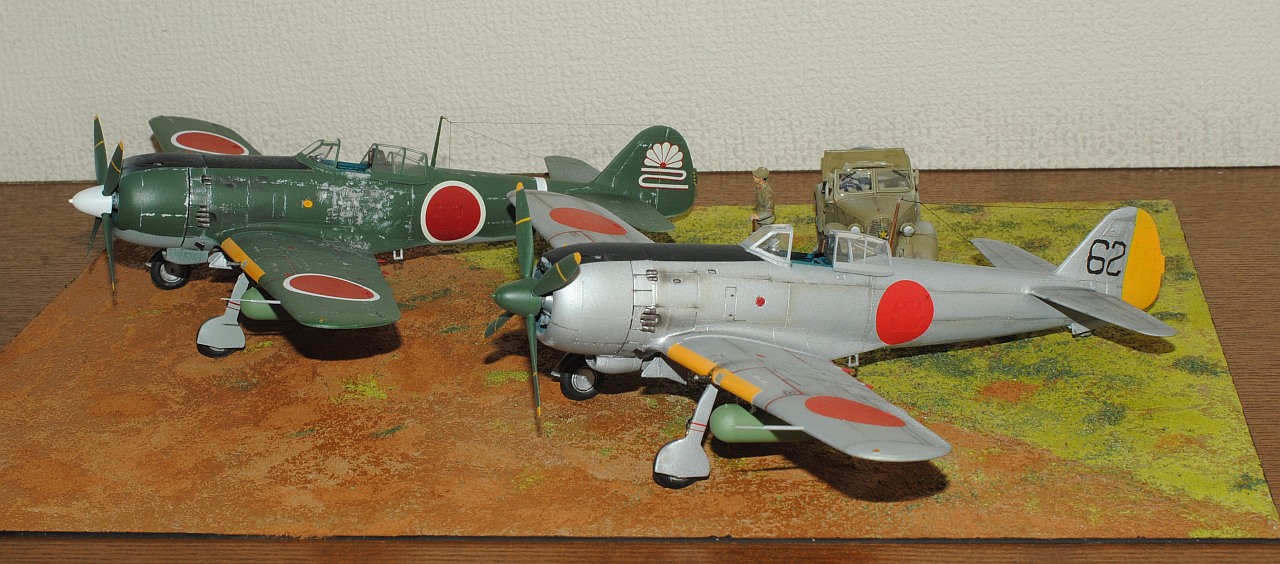
"Diorama completed on October 20 2012" (Crick to enlarge).

"Diorama completed on October 20 2012" (Crick to enlarge).
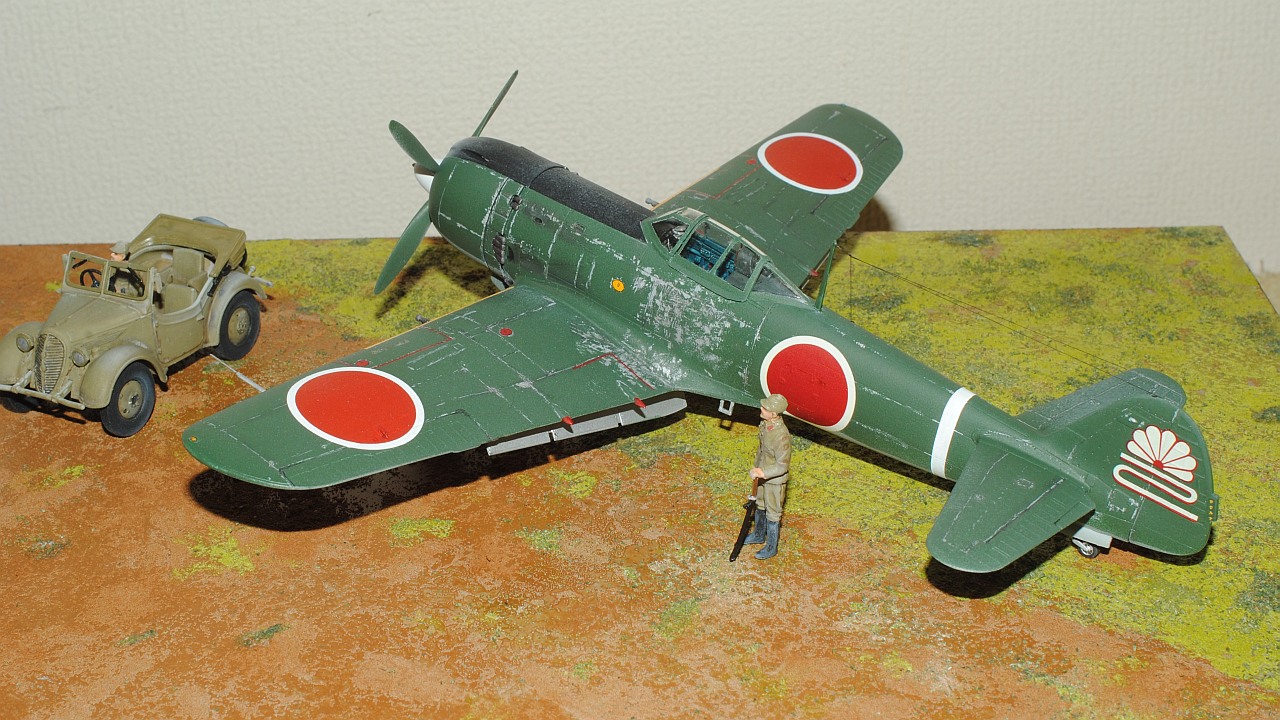
"Diorama completed on October 20 2012" (Crick to enlarge).

"Diorama completed on October 20 2012" (Crick to enlarge).

"Diorama completed on October 20 2012" (Crick to enlarge).
Chronology
2012.5.19: I started intererior painting.
2012.5.26-27: After additional internal painting, cockpit parts were glued, which was installed into temporarily assembled fuselage (Photo-1, Photo-2, and Photo-3).

This weekend's achievement
2012.6.2: Cockpit is almost finished, using eduard's (Czechoslovakia, now the Czech Republic) photo etched seatbelts - Two-shot, enlarged. I am working out tentatively that one cockpit is not installed and stays opened for display outside fuselage and one installed as usual.
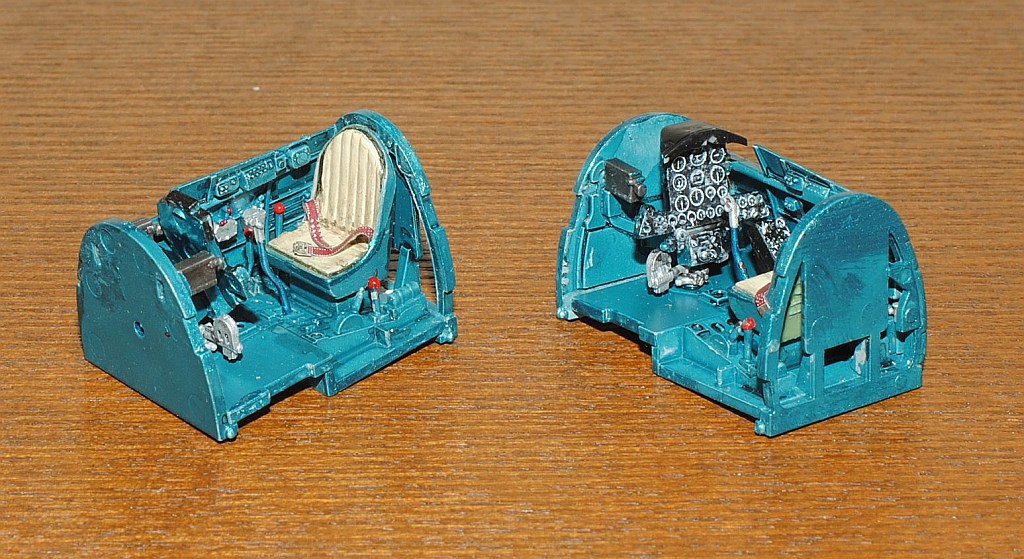
This weekend's achievement
2012.6.16. As I opted one cockpit not installed into the fuselage to display it separately, I made one vacant cockpit with scratch stuff (plastic board, brass wire, etc) and instant adhesive - Photo-1, Photo-2. Though not enough, but better than nothing.
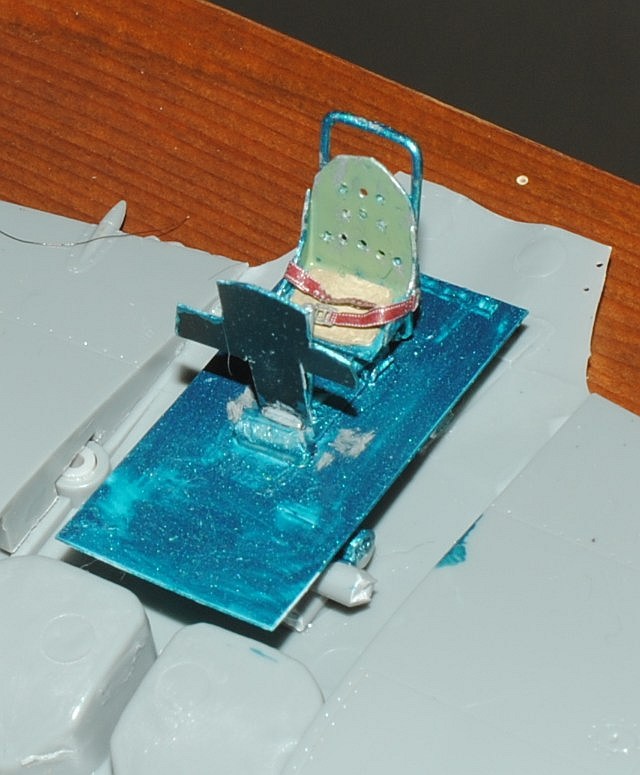
This weekend's achievement
2012.7.7. Nakajima Ha-45 "Homare" engine (meaning "praise" or, more usually, "honour" in kanji ideographic character) was assembled and painted. This compact 2000 horse-power engine is twin-row 18-cylinder radial one (Wikipedia page on Homare). In this kit, only front row is rendered. After painted in silver in different color shade, piping and wiring from spark plugs are added using brass wire of 0.3 (gold) and 0.4 mm (silver) in diameter and pin vice of 0.5 mm in diameter (left engine is original, right engine is upgraded one). Finally I retouched on these wires with silver (left is improved one, right original), and temporarily installed into the fuselage. Headrest is painted and glued.
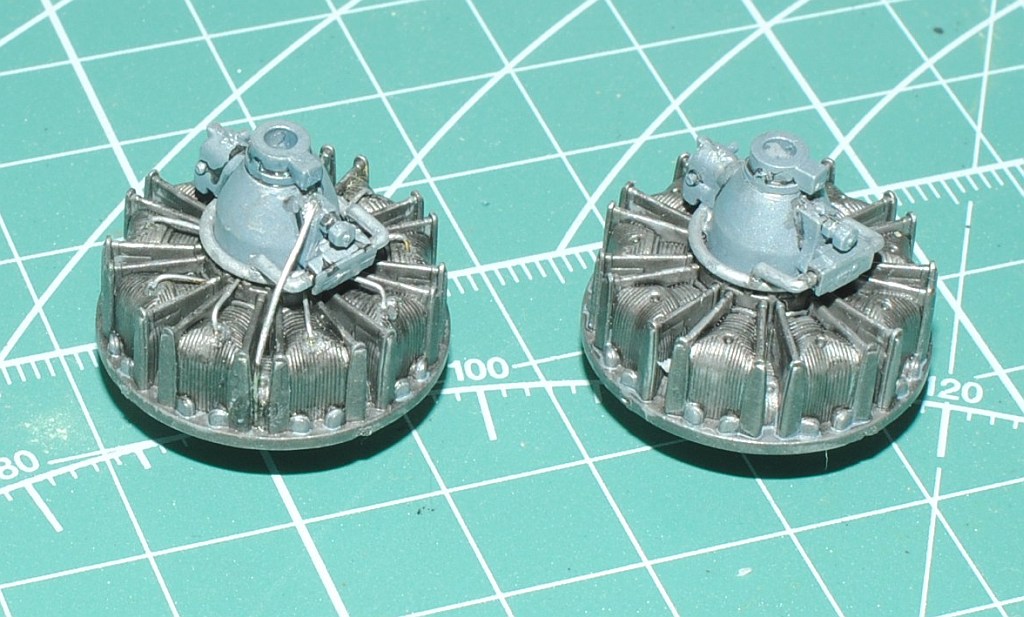
This weekend's achievement (Left is improved engine, right is original, as it is, from the kit package)
2012.7.14-15. One of the two Nakajima Ha-45 "Homare" engines (not yet upgraded original one) was transformed to "Two-Row" radial, using junk parts (one segment parts at individual resale) of Hasegawa 1/48 P-47 Thunderbolt (at the right upper, unpainted part) purchased at a specialized store at Akihabara (Yellow Submarine, at 20 Yen!). Piping was added to the front-row cylinders more minutely than in the preceding one (at right), and exhaust pipes were added to the second-row, using thicker brass wire and painted in annealed iron color (at left). Twin-row engine (made this weekend, at left) and original inadequate single-row engine (made in the previous weekend, at right) are compared. Actually, I gave up slicing the front-row cylinders slimmer because of technical difficulty, so the thickness of each row is not the same (please overlook,,). Second-row cyliders are glued to the fuselage, then front-row cylinders glued to the second row-cylinders. Front-view of this-week's upgraded engine shows minute piping and wiring. The bump from engine cowl to the suction mouth of oil cooler is rasped (green arrows). Internal surfaces of flaps and storage spaces of the undercarriages are painted in flat aluminum with additional weathering. Two Hayates are flying in tight formation (the weekend's product in the right side and the previous weekend's product is in the left side). I hope you recognize the more realistic appearance of the twin-row Homare engine.

This weekend's achievement (Left is this weekend's engine - twin-row!, right is the product of the previous weekend, now both engines upgraded from the original box)
2012.7.21. The glass part of the canopy is masked with masking tape and masking sol before spraying with surfacer gray - Photo-1 In formation, Photo-2 Enlarged view. This is one of the most cumbersome processes in model aircraft making.

This weekend's achievement
2012.7.27-28. All-out painting started. Firstly, surface primer (gray) was sprayed on two airframes. My plan is one of the two Ki-84s of the 22th Squadron (Regiment) will be painted in silver (see later diagram, first-stage advanced prototype under operationally-oriented practice flown by Major. Yoshihiko Kuroiwa at Nakatsu airfield, Kanagawa, in April 1944, let's call this plane "silver") and the other in dark green upper surface and light gray-sky under surface (for Lt. Uehara at Nakatsu airfield in February 1945, let's call this plane "green"). For "silver" I added panel-line accent brushing in the mid-night, drinking a glass of red wine, and sprayed silver very thinly in the next morning. "Silver" is placed on the painting schema (right upper corner). The upper surface of "green" is sprayed, in multilayer on surface primer, silver on the uppersurface with additional panel-line accentuation, and on these base paint final dark green will be sprayed and then be scraped to reveal base silver (three layer: gray surface primer + silver + dark green). The undersurface is already sprayed with surface primer, and now panel-line accentuation is added.

This weekend's achievement
2012.8.11-12. Anti-glare black painting of the nose section and orange-yellow painting for IFF (identification friend or foe) of the anterior tip of the main wing: After masking for anti-glare black painting is done with tape, flat black was painted on the nose with brush. Ditto, after masking for orange-yellow IFF painting with tape and masking sol, almost all airplane is enveloped with paper in its entirety, and front edges are sprayed firstly with Tamiya surface primer (white!) and with Mr.Color No.58 Orange Yellow for WW-II Japanese IFF. Looking not bad after masking tapes are peeled off (this plane is for "green") .

This weekend's achievement
2012.8.18-19. Painting of main fuselage: Upper surface is sprayed dark green (Nakajima, Mr.Color J 129), then underside is sprayed light gray after masking with use of Blu-Tack (I owe this technique to Andy in Nara). Underside is shot together, "silver" and "green", and upper side as well. Weathering is rendered to upper green by whittling with desing knife.
.

This weekend's achievement
2012.9.8. Exhaust tubes are cemented and propellers are painted: Propeller blades are masked with tape, painted orange yellow using brush, then sprayed dark green (Nakajima, Mr.Color J 129). Exhaust tubes are cemented to the engine cowling, after painted. Looking good - "silver" and "green".
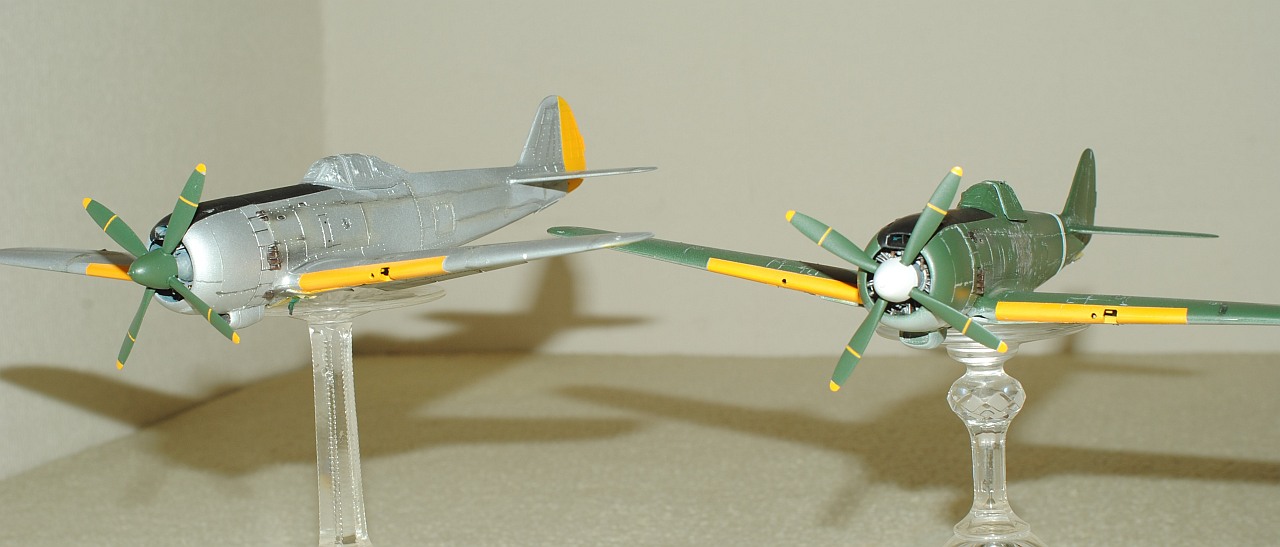
This weekend's achievement
2012.9.15-16 (three-day weekend). 20-mm cannon tubes are bored using 0.5-mm pin vice, with results before final fairing. After landing light is installed using scratch material (toothpick), cannons and light cover are glued. After masking with tapes, red lines indicating walking prohibition is painted using brush on the "silver" main wing, with result. Brake pipes are added to the main undercarriages, before and after pipes being painted black. Now is the time for temporary assembly: "silver" and "green", underside of "green".

This weekend's achievement
2012.9.22-23. The number "62" on the vertical tail fin of the "silver" is the problem. I could not find out the proper sized "62" from decals of other surplus and junk items, so I decided to DIY stencil by cutting masking tape with design knife. The original drawing of "62" is rather rush job, maybe done on the airfield by the 22 Regiment after deployment, with characters appearing rather lumbering. O.K. difficult job well done. Flaps and undercarriage doors of medial side are glued. AeroMaster's decal (Florida, USA) for Ki-84 was partly used (rising sun - Hinomaru in Japanese - on the upper side of the main wings of the "green" and rising sun with no white edges for the "silver). After applying decals and spraying flat clear, I in some trepidation detached masking tapes of the wind shield glasses of the "green". Not bad!, with the other angle and Homare engine under-maintenance circumstance (as you know this is not real shape on the ground, front round edge remains as it is with only side panels detachable). Decals are applied to the "silver" too (flat clear spray not yet done, so residual masking for wind shield, await for a while).
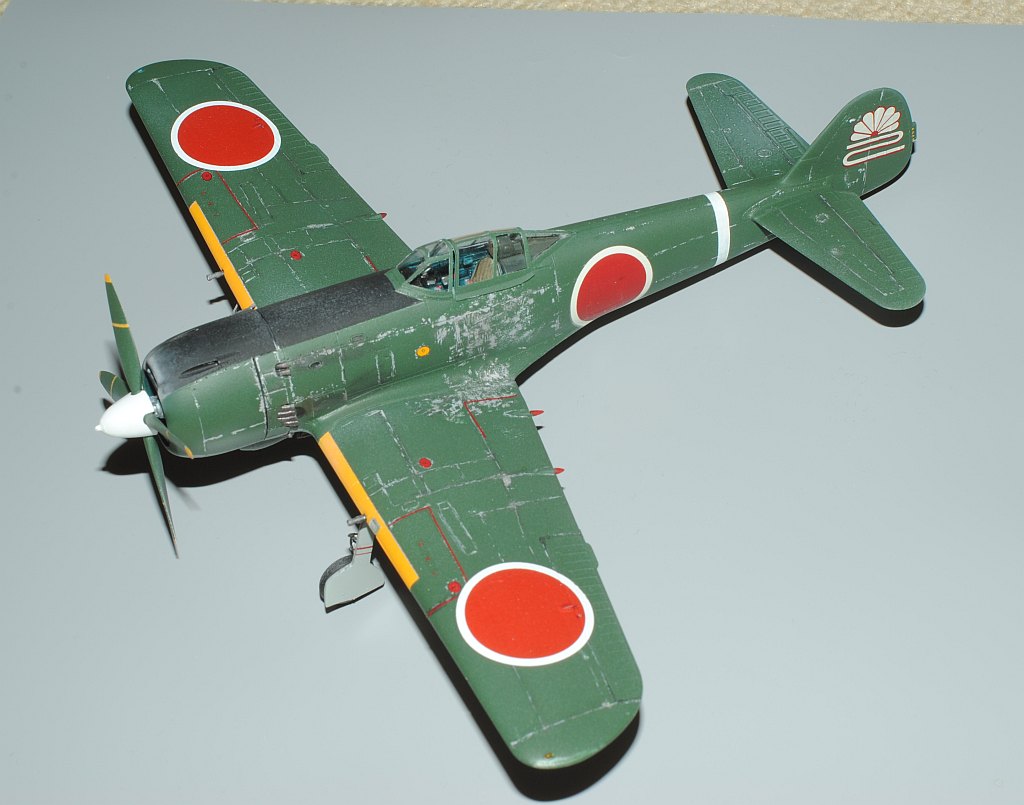
This weekend's achievement
2012.10.6-8. I made pitot tube using injection needle (21G) and brass wire 0.3 mm with quick setting adhesive. After spraying flat clear on "silver" to protect decals, in some trepidation as usual, I detached masking tapes of the wind shield glasses of the "silver". Antenna wires were weaved using disposed stocking and quick setting adhesive which I was given by my seasoned wife. I would advise you to think at least twice before requesting disposed stocking to woman before or outside your marriage. Now, diorama is prepared with TAMIYA diorama texture paint Soil Effect and Grain Paint Green on thick plastic sheet. I hope I were impressionist-school artist. Now bivouac just before approaching the summit - Two shot, ""silver"-1, "silver"-2, "green"-1, "green"-2, "green" in engine maintenance-1, "green" in engine maintenance, close-up. As a final step, I am planning a diorama in which air commodore is visiting Nakatu Airfield on Kurogane 4x4 light vehicle to spur and thank for courageous spirit.
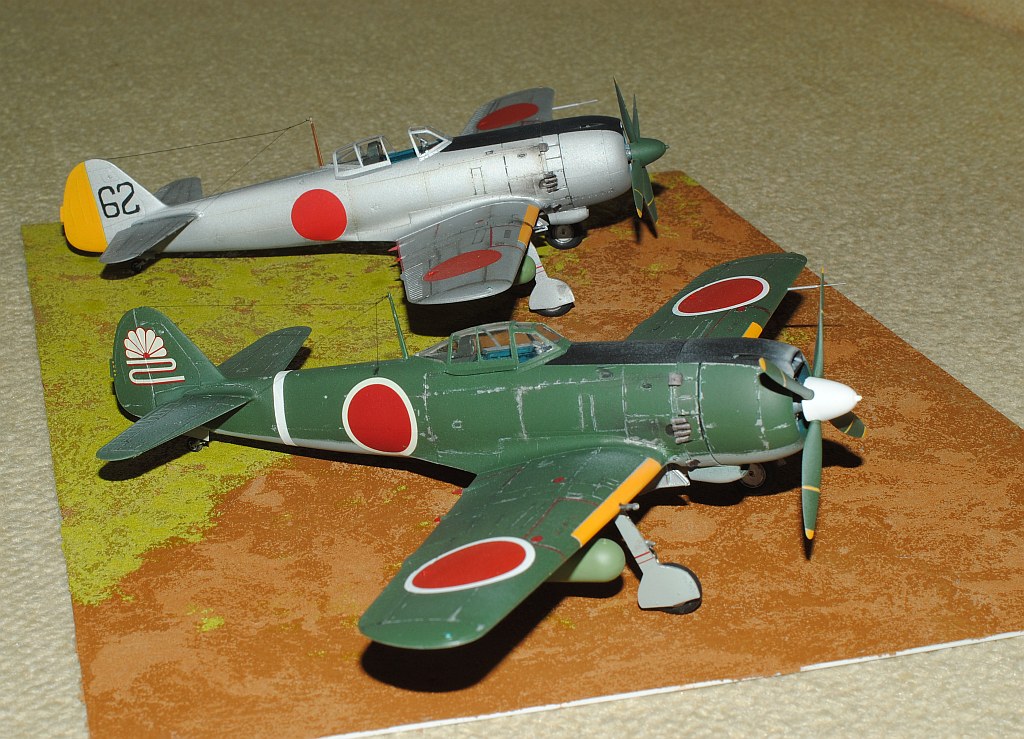
This weekend's achievement
2012.10.13-14. Ground surface of the diorama is additionally worked over, scattering country grass of different flavors which is fixed with specified adhesive agent (acryl emulsion, Super Fix). Kurogane 4x4 light vehicle is now being built, but not yet completed - on the work table and jumping rashly to the diorama.
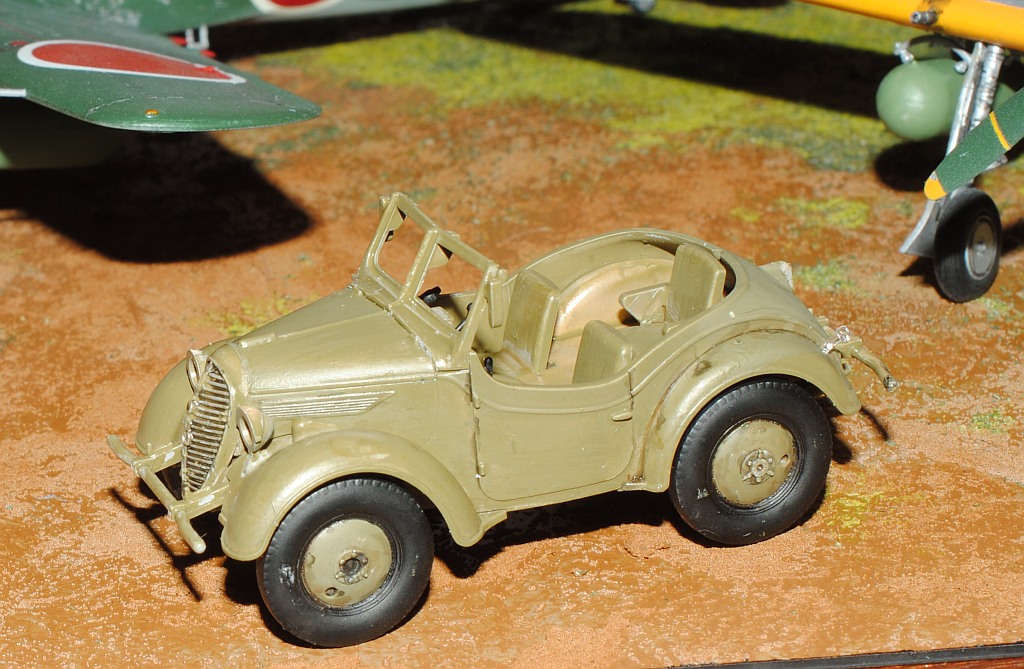
This weekend's achievement
2012.10.20-21. Kurogane 4x4 light vehicle is completed, which is given deep weathering, maybe too deep. Air commodore is toting samurai sword. After all the work is accomplished, diorama is displayed on the work table. I did it! - jubilant with a glass of whisky on the rock.
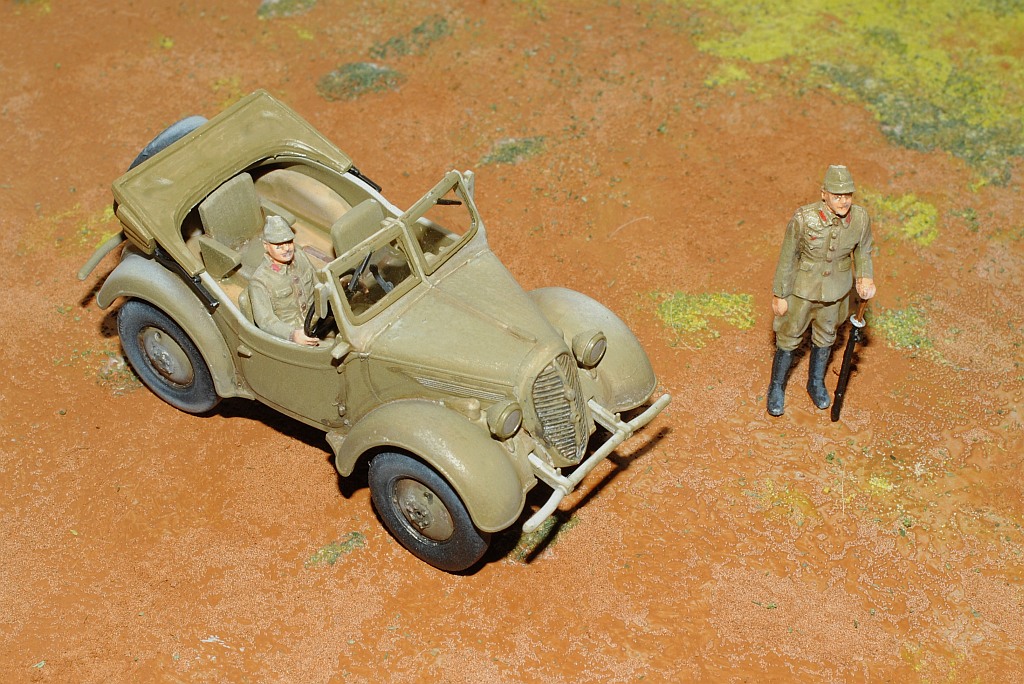
This weekend's achievement-1
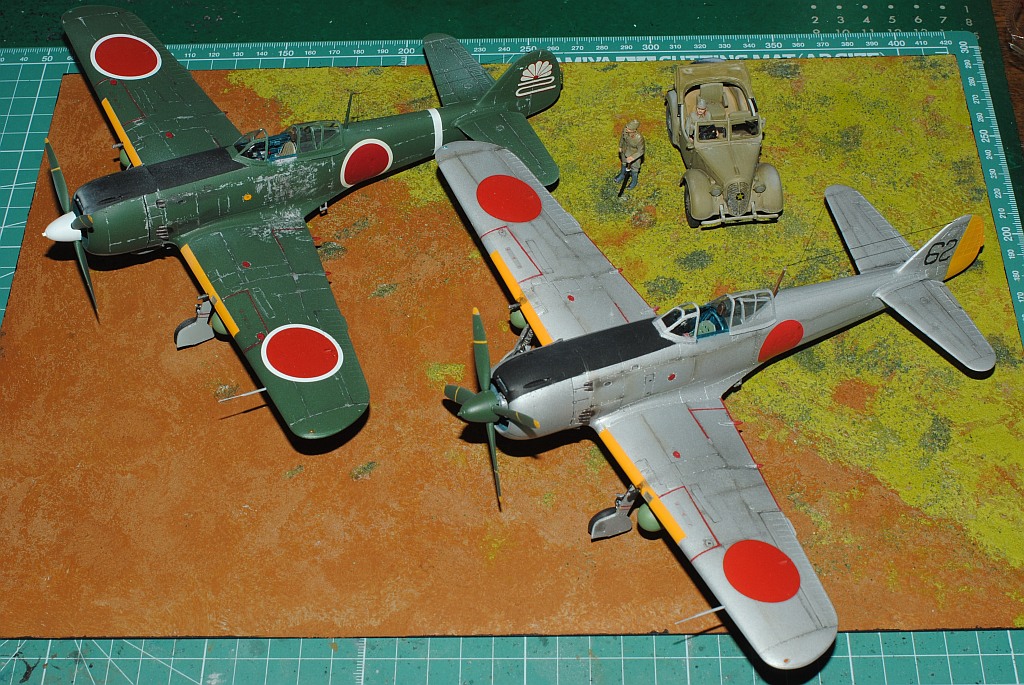
This weekend's achievement-2
2012.11.18. [Addendum] Pilot figure is added using Hasegawa WW.II Pilot Figure Set (RAF pilots on both sides), which appears in the diorama as this.
Back to "Scale Model Hobby" Index Page
version 1.00 2012/11/19
Please send your comments to akio-h@fg-khn.jp
Back to previous Home Page at AOL (Till October 31 2008)
Back to previous Home Page at geocities.jp web host (Till March 31 2019)
Back to New Home Page (Translocated Sakura server)























